Each year I take a “ride into Autumn,” driving into the kaleidoscopic crimsons, golds, and greens of fall foliage at its peak.
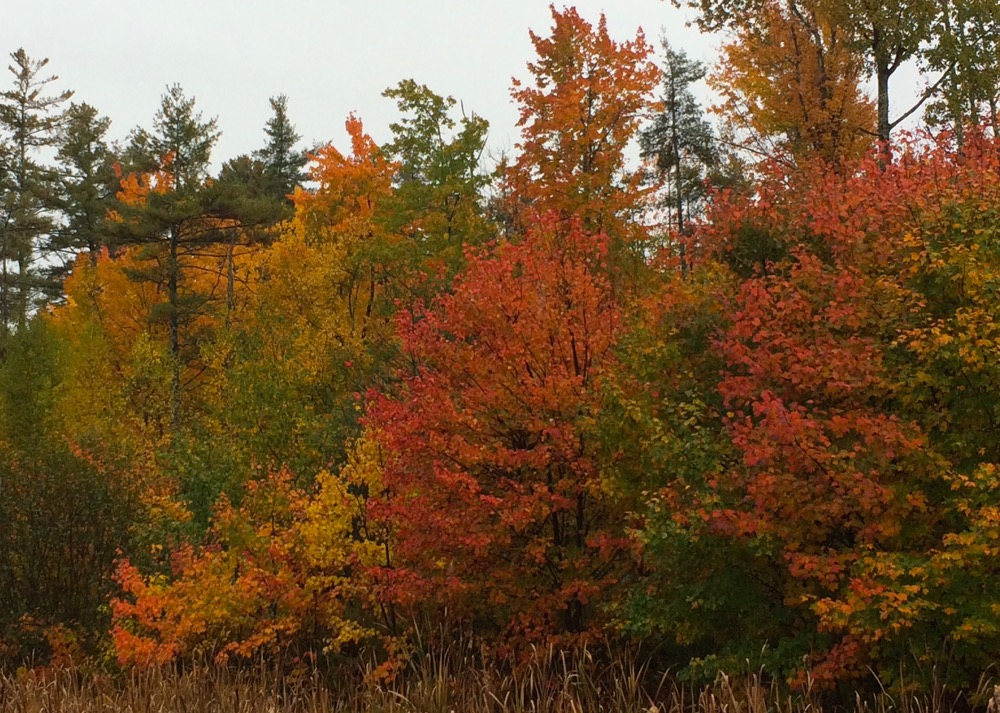
Fresh air carries a whiff of apples and cider donuts. Pumpkins rest in fields waiting to be chosen by children giddy for Halloween. Hudson Valley’s high-quality produce is easy enough to find at Union Square Greenmarket and other markets throughout New York, but nothing beats going directly to the source. I made a priority of seeking out the best markets but sprinkled in other sightseeing too. Here are a few highlights.
Stone Barns Center for Food and Agriculture and the restaurant Blue Hill at Stone Barns: Located in Pocantico Hills in the Lower Hudson Valley, Stone Barns Center is a nonprofit organization that’s a hybrid working farm and education center focused on creating a sustainable food system. The restaurant Blue Hill at Stone Barns, led by Chef Dan Barber, is deserving of its outsized reputation as a mecca for foodies. I was so energized by my visit to the Center and Blue Hill restaurant that I’ll be publishing a separate blogpost about those experiences.
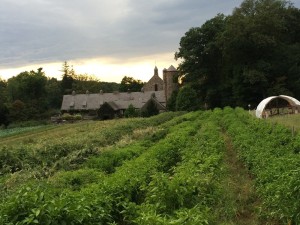
planted fields at Stone Barns Center

Vegetables center stage Blue Hill at Stone Barns
Kykuit: Part of the Rockefeller family’s estate that was bequeathed to the National Trust for Historic Preservation, the mansion is open to public tours. Built for John D. Rockefeller Sr., “Kykuit” (the pronunciation rhymes with “high cut”) is Dutch for lookout or high place. As mansions go, this one is not so much ostentatious as it is proud and stolid.
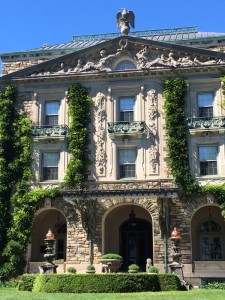
Rockefeller estate Kykuit
The house showcases Chinese porcelain collected by John Jr. who moved in after his father’s death. But the more compelling reasons to visit Kykuit are the spectacular grounds and sculptures.
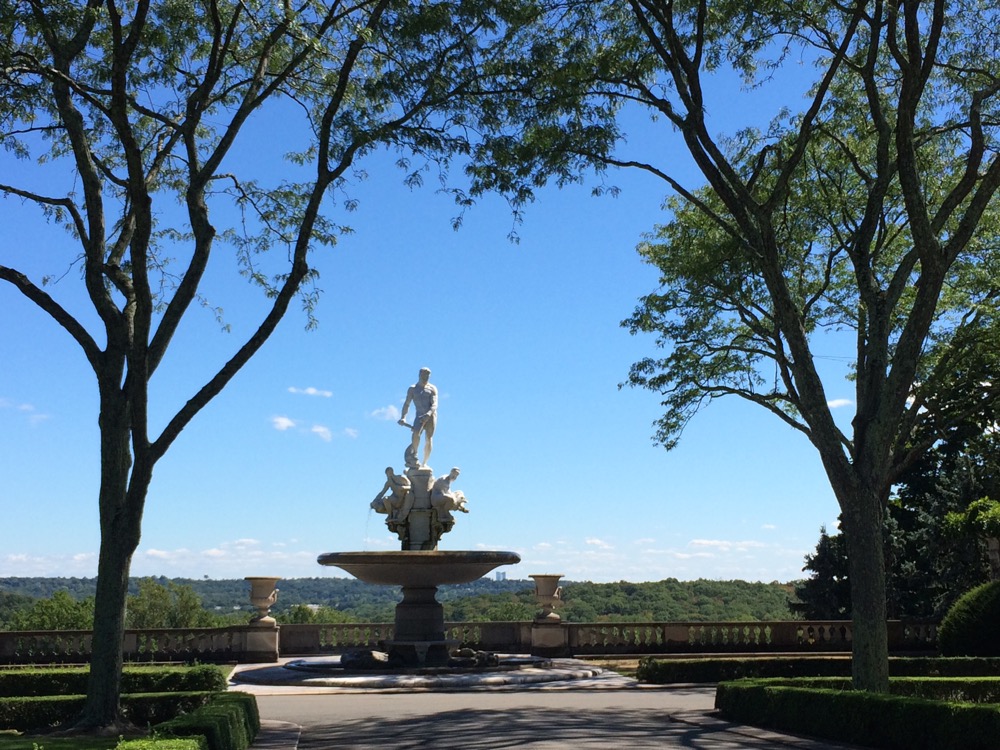
Kykuit
Wide open spaces dotted with specimen trees lead to a succession of formal gardens and allées of linden trees. Each garden forms its own room and frames views of the house or the Hudson River. Sculpture was a passion of Nelson Rockefeller (grandson of John D., former governor of New York, and vice-president under Gerald Ford). He took such interest in the placement of each piece that he’s said to have hovered over the estate in a helicopter to determine the best siting. It’s an inspiring and beautiful place. Tours are operated by Historic Hudson Valley and depart from the visitor’s office in Sleepy Hollow.

near the entrance to Kykuit
Culinary Institute of America: The CIA, as it’s known, is more than a cooking school. It’s an accredited culinary college offering several well-rounded degree programs as well as hands-on programs for food & wine enthusiasts and professionals. Located in Hyde Park on a site that was once was Jesuit novitiate, the CIA is one of the major drivers behind the Hudson Valley’s ascendance as a destination for foodies. Many CIA alums have stayed in the area working as chefs or in other capacities in the food industry.
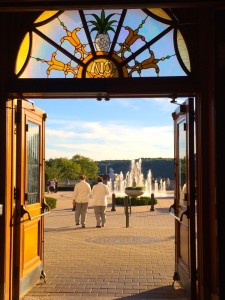
Culinary Institute of America, NY
The school’s success has spawned CIAs in St. Helena, California; San Antonio, Texas; and Singapore, but the campus in Hyde Park, New York is their original and largest. Facilities include well-equipped kitchen classrooms, bakeshops, demonstration theaters, and several restaurants that are operated by a rotating crew of CIA students and open to the public. I dined in American Bounty which purports to feature Hudson Valley specialties. It does to some extent. Lackluster flavors made for a disappointing meal, but the server was earnest and mannered. I had to remind myself that the students are not full-fledged professionals yet. I look forward to returning and giving the restaurants a second try.
Hudson: This river town with its several blocks chock-full of antiques shops, art galleries, and trendy eateries has been attracting so many artsy types that real estate prices have spiked in recent years. While this has created some friction between well-heeled weekenders and long-time residents who struggle to scratch out a living, a stroll along Warren Street is like walking back in time and very pleasurable.
The dealers’ collective at Hudson Supermarket offers a range of antiques and art & design objects. For specialty food provisions, both Talbott & Arding and Olde Hudson have a broad selection. Paula is an atelier with distinctive ceramics. Outsider artist Earl Swanigan’s paintings can be found at Eustace & Zamus Antiques.

Earl Swanigan painting
The Hudson Farmers’ Market is worth checking out. It’s Saturday from 9 am-1 pm, from mid-April to mid-November. Hudson’s market began in 1997 with five vendors and has swelled to about seven times that size and is now the largest in Columbia County. It’s a lively marketplace with people of all ages and incomes (some shopping with SNAP benefits, formerly known as food stamps). The emphasis is fresh produce, but there’s also cheese, grass-fed beef, flowers, pickles, and breads.

sauerkraut vendor at Hudson market
Hillrock Estate, an artisan distillery in Ancram, NY, is controlling the whole process from farming to distilling and creating fine bourbon, rye, and single malt whiskey. Bonfiglio & Bread’s stand has a line of devoted customers, as does its bakery in Hudson. Bialys topped with crispy onions strike a balance of chewy, light deliciousness. The owners recently opened Lick ice cream shop. Blue Star Farm, Red Oak, and Sparrowbush are a few of the farmers’ stands. I overheard a photographer asking the farmer at Sparrowbush for more blue eggs for a photo shoot. Although he bought a half-dozen the previous week, he hadn’t been able to resist cooking and devouring them.

Saturday farmers’ market in Hudson NY
Hudson has a slew of restaurants and cafés serving up good fresh fare. These include Wm. Farmer & Sons, Swoon, Café le Perche, Crimson Sparrow, Ca’Mea, Lil’ Deb’s Oasis, and Fish & Game which offer a range of price points and cooking styles.
Olana is the Hudson estate of Frederic Church and worth a visit if time permits. Church was one of the foremost Hudson River School painters. Tours of his house and the grounds are scheduled separately. Reservations recommended.
I look forward to returning to Hudson for the Basilica Farm and Flea over Thanksgiving weekend.
Kingston: This river town lays claim to being the first capital of New York since the state’s constitution was drafted here in 1777. That didn’t last long because the British invaded and burned most of the town. Later rebuilt and rejuvenated as a manufacturing town, Hudson found prosperity as a producer of cement, bricks, and bluestone. After the decline of manufacturing, Kingston is regaining footing as a hub for agriculture and the arts.
The Kingston Farmers’ Market is a vibrant Saturday market (9 am-2 pm) from late May to November. There’s a winter market the first and third Saturdays of each month, 10 am-2 pm, from December through April in the Old Dutch Church. The outdoor market sprawls along several blocks of Wall Street between John and Main streets. There’s music, farmstead cheeses, baked goods, ice cream, flowers, small-batch distilled whiskeys, pasture-raised meats, and fresh local produce. The bounty of the Hudson Valley harvest is well represented at the Kingston market. About 40 stands line the sides of the street, which is also rich with architectural and historical interest.
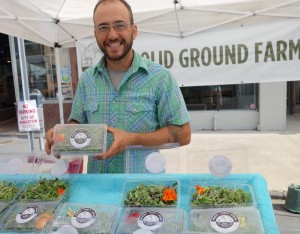
Kingston farmers’ market

downtown Kingston
I talked with Ken Migliorelli, owner of Migliorelli Farm, who operates a large stand at this market and others including Union Square Greenmarket in Manhattan. He spoke about the saturation of New York markets, which makes it difficult for farmers to eke out a decent reward for their labors. He has reduced the number of markets that he attends to focus on the bigger ones and to better control costs.
An example of Kingston’s rejuvenation of industrial sites is Smorgasburg. About a 12-minute drive from downtown Kingston, Smorgasburg opened in August 2016 as a combo food and flea market at the abandoned Hutton Brickyards. It’s a scenic spot next to the Hudson River directly across from Rhinebeck. Smorgasburg is an outdoor Saturday market, open May through October. It’s a spin-off of Brooklyn Flea. About 50 vendors sell an eclectic smattering of edible or vintage items.
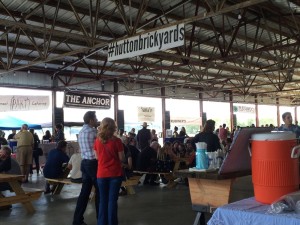
Smorgasburg Upstate in Kingston NY
The food is weighted toward ready-to-eat items rather than fresh produce. If you come hungry, you will leave full—sated on wood-fired pizza, lobster rolls, hot sausages on a stick, or grilled cheese sandwiches. Wine-barrel tables and grassy areas are inviting for a freestyle picnic.
Rhinebeck: This upscale enclave in the mid-Hudson Valley is across the river from Kingston. Infused with youthful energy thanks to its proximity to Bard College, there are plentiful boutiques and eateries. My main reason for coming here, though, was to explore its farmers’ market which has the reputation as the oldest in the area. (This is its 23rd season.)
Rhinebeck Farmer’s Market is Sunday from 10 am-2 pm, from Mother’s Day until the Sunday before Thanksgiving. About 35 stalls are clustered in a parking lot off E. Market St. with vendors selling eggs, cheese, meats and charcuterie, baked goods, spirits, honey products, and fresh produce. During winter, the Rhinebeck market moves indoors to Rhinebeck’s town hall every other Sunday. Market manager Andrea Bartolameo aims for a mix of growing styles: certified organic, non-certified organic, biodynamic, and conventional. Live music and a tasting event add excitement to an otherwise sleepy Sunday morning.
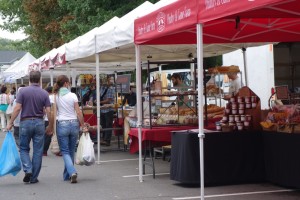
Rhinebeck farmers’ market
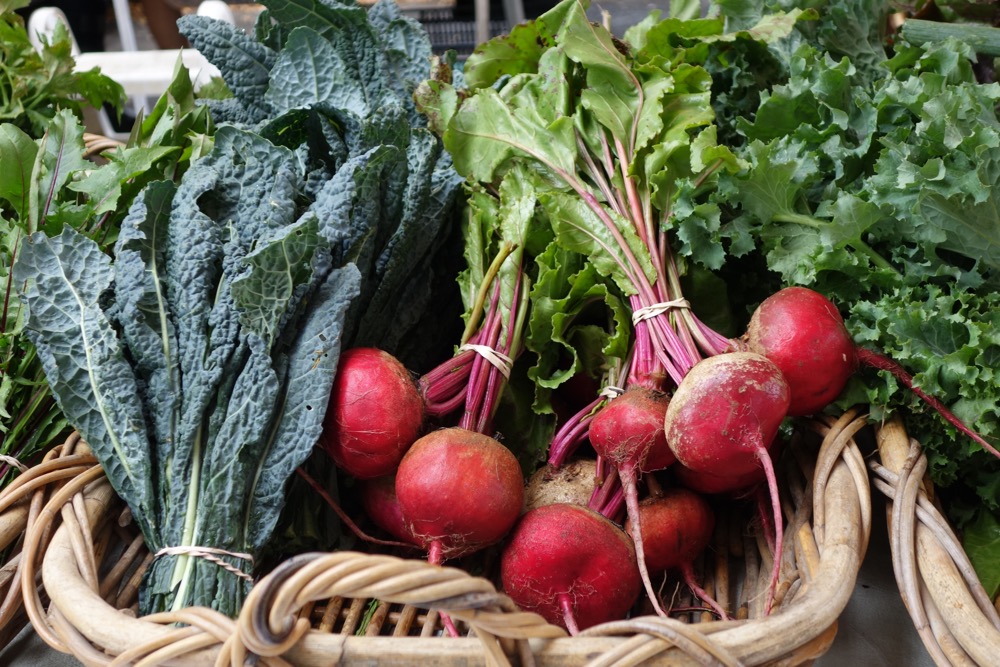
fall harvest Rhinebeck
Taliaferro Farm was the first at this market to offer organic produce. Breezy Hill Orchards sells pesticide-free fruits and ciders. Chaseholm Farm Creamery is a multi-generational family farm with Sarah Chase milking the cows and her brother Rory making the cheese. Yellow Bell Farm, based in Redhook, is in its third generation of poultry farming with Katie Bagdanfy now running the farm. In addition to chicken meat and eggs, they also sell a hearty homemade bone broth and bourbon-flavored chicken liver paté. While the emphasis at this market is on local agricultural products, there are also crafts vendors. A woodworker creates boards from fallen trees. River Ridge Textiles specializes in hand-dyed scarves and handspun wools. If you’re looking for something to eat right away, a falafel sandwich from Aba is as flavorful as it is filling.
Storm King Art Center: This outdoor sculpture garden features large-sized works by artists such as Andy Goldsworthy, Maya Lin, and Alexander Calder. Some were designed specifically for this 500-acre park, and there’s plenty of room for each to breathe. I highly recommend visiting Storm King. If you do, bring comfortable walking shoes. Located in New Windsor, NY, close to West Point, it feels like an otherworldly place where imagination reigns supreme.
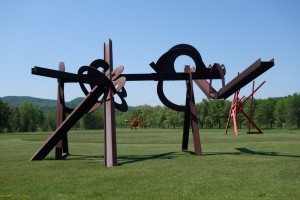
Storm King
Hudson Valley’s bevy of attractions—food, antiques, markets, gardens, and much more—are a siren call for a ride into Autumn, although substantial and varied enough to tempt in every season.
Related Posts:
Basilica Farm & Flea Market (Hudson, NY)

6 comments. Leave new
Great to see the region of my birth in a whole new light. What great art, food, & happenings.
YOU are another of Kingston’s claims to fame!
Lovely article! Thanks so much. You made me want to jump in the car and head straight for the farmers’ markets and antique shops in the Hudson Valley!
Thanks, Betty. BTW, I saw your books at Hammertown–what a great shop!
I’ve heard that store is fabulous. It’s not so far from me so I should make a trip!
It is. Go!